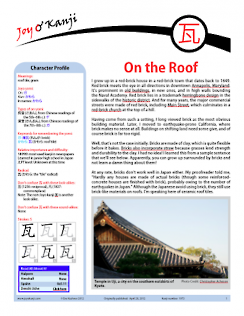瓦
roof tile; gram; "tile" radical
Kanji 1973
Thank you for visiting this Character Home Page. Below you'll find a synopsis of the essay. If you wish to read the full text, the PDF of the essay is available for purchase to the right.
Architecture buffs: don't miss this one! As the fantastic photos show, old Japanese buildings often feature striking roofs with alternating ridges and valleys of semi-cylindrical tiles, as well as elaborate decorative caps and unusual rooftop figurines. By studying 瓦 (a new Joyo kanji), you’ll learn to talk about all this and so much more! You'll find out about the unexpected glamor of bricks in the Meiji era, 瓦 in words about metaphorical collapses, and this shape as a radical in several fascinating kanji.
Revision history:
July 2, 2021:
- p. 2, Etymology Box: Replaced the Henshall etymology with the new one.
- p. 2, main text: Reworked the first few paragraphs, introducing the two Joyo yomi more clearly.
- p. 13: Added a link to the Kanshudo games.
Jan. 27, 2017: Revised the vocabulary under a sample sentence on p. 6.
Jan. 23, 2016:
- p. 5 sidebar: Changed Edo era dates to 1603–1867.
- p. 13 sidebar: Revealed text that was covered up at the bottom!
- Fixed broken links on pp. 1, 2, and 15.
Aug. 24, 2012: Added two pictures to p. 17. One photo caption describes types of sweets in the shape of roof tiles!
Apr. 30, 2012: Added two pictures of 鬼瓦 (おにがわら: ridge-end tile with the figure of a devil or gargoyle).



Comments